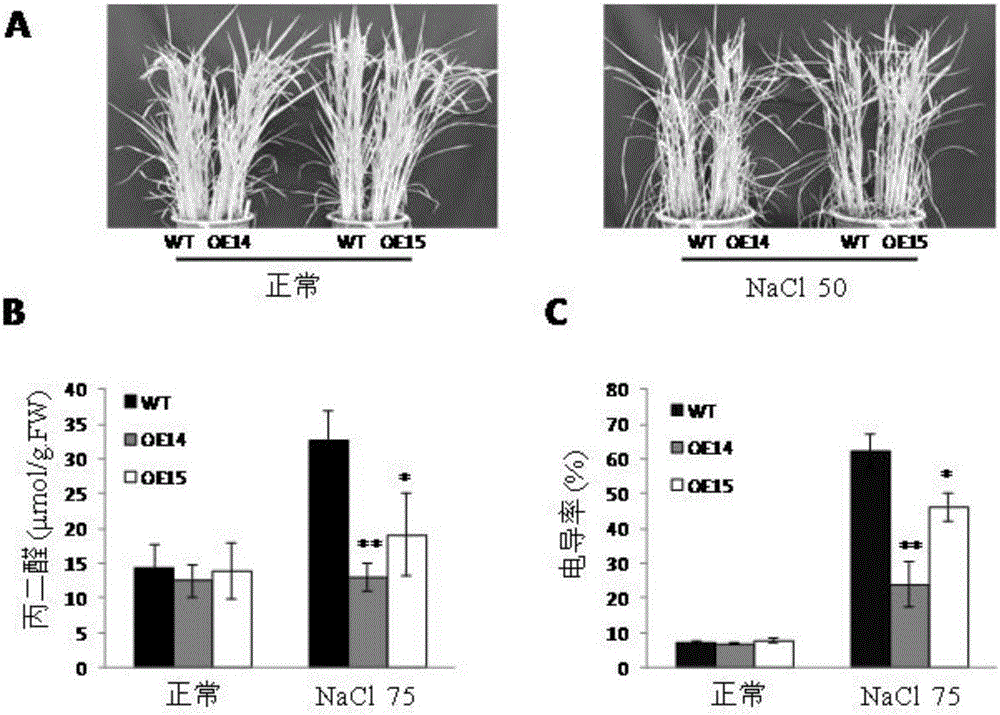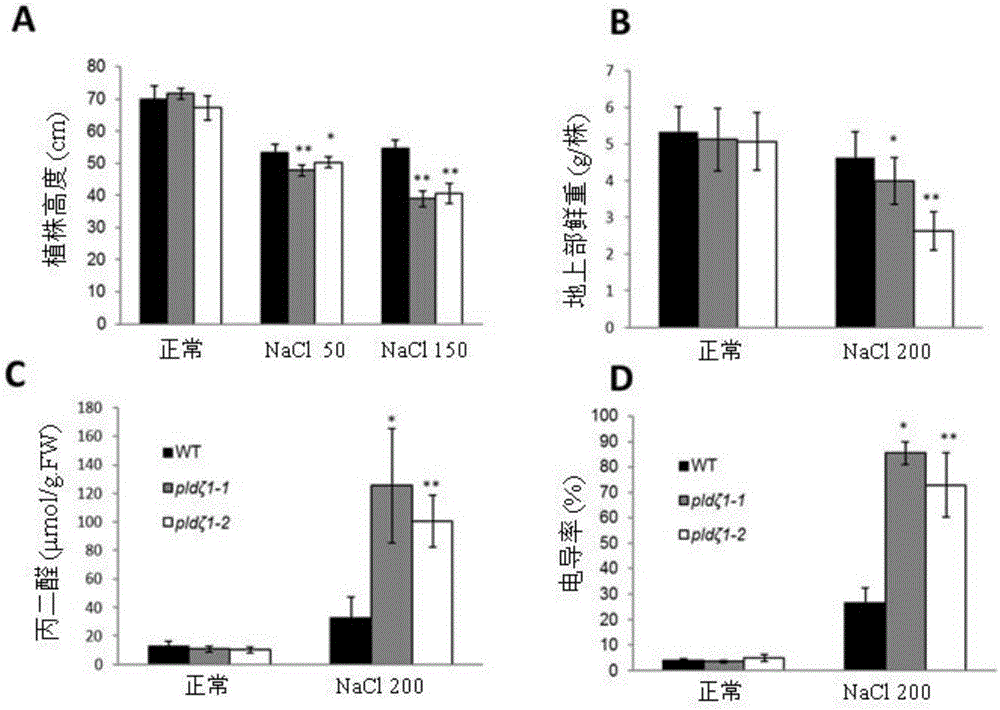Application of phospholipase gene PLDzeta1 in improving salt resistance of plant
A technology of salt tolerance and genetics, applied in the field of plant molecular breeding and biology, can solve problems such as complex molecular mechanisms
- Summary
- Abstract
- Description
- Claims
- Application Information
AI Technical Summary
Problems solved by technology
Method used
Image
Examples
Embodiment 1
[0030] Cloning of PLDζ1 Gene and Its Overexpression Enhances Plant Salt Tolerance
[0031] 1. Cloning of full-length cDNA of PLDζ1 gene and construction of plant overexpression vector:
[0032] Total RNA was extracted from the leaves of japonica rice Dongjin, and the first-strand cDNA was synthesized by reverse transcription RT-PCR using mRNA as a template. Then, using the cDNA as a template, the sequence-specific primers PLDζ1FZ: 5'-GGGGTACCATGCAAGAATATCTGAACC-3' and PLDζ1RZ were used: 5'-CGGGATCCATGGAAAACTTTGGGAG-3' was amplified by PCR, and the target fragment obtained by amplification included the sequence shown in SEQ ID NO.1. The amplified target fragment was inserted into the enzyme cleavage site of the plant overexpression vector pU1301D1 (modified by pCAMBIA1301, Hajdukiewicz et al., The small, versatile pPZPfamily of Agrobacterium binary vectors for plant transformation. Plant Mol. Biol. 1994, 25: 989-994) Between Kpn I and BamH I, the pU1301D1:PLDζ1 recombinant pla...
Embodiment 2
[0044] PLDζ1 overexpression enhances salt tolerance in plants
[0045] Two PLDζ1-OE independent lines, OE-14 and OE-15, of the PLDζ1-overexpressing rice transformed plants created in Example 1 were randomly selected for detailed analysis, and non-transformed regenerated plants (wild type, WT) that had also undergone the tissue culture process were selected. As a control, they were treated with different concentrations of NaCl solutions (0, 50, 75 mM) for one month during the tillering stage. The results showed that under normal conditions, there was no significant difference in plant height, leaf plasma membrane permeability and malondialdehyde content between PLDζ1 overexpressing plants and the corresponding wild type, but under salt stress conditions, the survival rate of PLDζ1 overexpressing plants significantly higher than the wild type, and its leaf plasma membrane permeability and malondialdehyde content were significantly lower than those of the non-transformed wild typ...
Embodiment 3
[0047] Isolation, Characterization and Gene Function Characterization of PLDζ1 Deletion Mutants
[0048] 1. Isolation, identification and phenotype observation of mutant pldζ1:
[0049] In order to further verify and analyze the function of PLDζ1 gene, the present invention isolated and obtained two independent mutant lines with T-DNA inserted into different sites of PLDζ1, named pldζ1-1 and pldζ1-2 respectively, wherein the T-DNA of pldζ1-1 was inserted is located in the 3'-UTR region of PLDζ1, while the T-DNA insertion of pldζ1-2 is located in the third intron of PLDζ1. The effect of T-DNA insertion on the expression of PLDζ1 was analyzed by semi-quantitative RT-PCR. The results showed that the expression of PLDζ1 in the homozygous mutant of pldζ1-1 was slightly lower than that of the wild type, while that in the homozygous mutant of pldζ1-2 PLDζ1mRNA could not be detected, which belonged to the complete deletion mutant.
[0050] The analysis showed that PLDζ1 was induced ...
PUM
 Login to View More
Login to View More Abstract
Description
Claims
Application Information
 Login to View More
Login to View More - R&D
- Intellectual Property
- Life Sciences
- Materials
- Tech Scout
- Unparalleled Data Quality
- Higher Quality Content
- 60% Fewer Hallucinations
Browse by: Latest US Patents, China's latest patents, Technical Efficacy Thesaurus, Application Domain, Technology Topic, Popular Technical Reports.
© 2025 PatSnap. All rights reserved.Legal|Privacy policy|Modern Slavery Act Transparency Statement|Sitemap|About US| Contact US: help@patsnap.com



